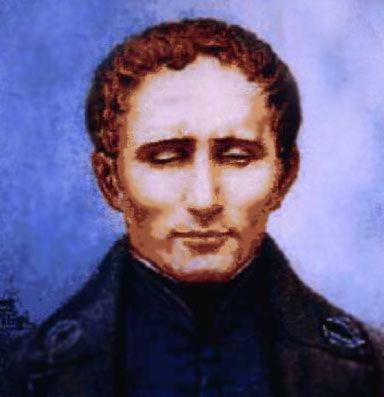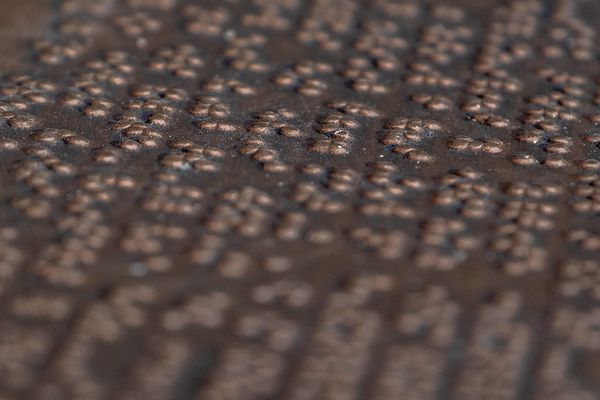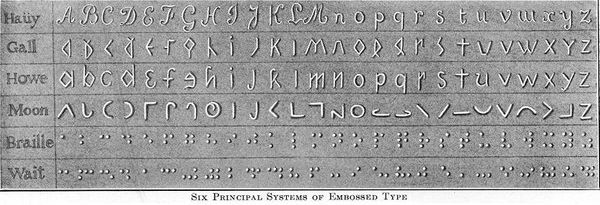Making its Mark: the English Braille Script’s History and Journey
For most people, Braille is instantly associated with the lives of the visually impaired. But as late as the 19th century, there was no script designed for people with visual impairments to be able to read and write. Braille was a pivotal moment in the history of addressing disability rights, and today, along with its value as a tool of communication, it offers the visually impaired community ways to assert their identity. This revolutionary script has a storied history, one that begins with a blind teenager in 1820s France.
The Early Days
Louis Braille was born in 1809, in the small French town of Coupvray. Having lost his sight at the age of 5 in an accident in his father’s workshop, Braille went on to attend one of the first blind schools in the world, the Royal Institution for Blind Youth in Paris. Here, amongst his blind and visually impaired peers, and facing the condescension of school administrators who didn’t envision an independent life for a visually impaired person, young Louis sought to change the way people like him wrote and read - and hence socialized.

Braille’s spark of inspiration came in 1821 from encountering ‘night writing,’ a code of dots and dashes in thick paper that could be interpreted by touch, devised by Captain Charles Barbier of the French Army. However, with its 12 dots - where each dot stood for a letter or phonetic sound - this was too cumbersome and complicated for a blind reader to grasp at once. 15-year old Braille took this foundation, and with 6 dots, made the crucial improvement that allowed a reader to ‘read’ the entire cell unit with one impression of a fingertip and move rapidly from one cell to the next. This was the invention of the widespread system for reading and writing to be used by people who are blind or visually impaired that now bears his name, and remains basically as he invented it.
Braille remained a vociferous advocate for the blind and their education throughout his life. He published the first Braille book, Method of Writing Words, Music, and Plain Songs by Means of Dots, for Use by the Blind and Arranged for Them, in 1829, at age 20. A talented musician, he played the piano and also developed a Braille musical codification.

Still, the Braille script faced challenges from entrenched ideas of education and social inclusion - including from sighted educational authorities and the government of France. Braille’s system also made it possible for the blind to be teachers of the blind, further strengthening resistance to the raised-dot system by sighted teachers. Nevertheless, Louis Braille persisted, exhibiting the script and its benefits to many of the industrialists, luminaries, and even royalty of his time. Although he passed away in 1853 at the age of 43, a year later his home country of France adopted Braille as its official system of written communication for blind persons. The journey had begun.
Braille Makes its Mark
The first country outside France to begin using Braille was the USA, where the Missouri School for the Blind in St. Louis adopted the script in 1860. It was introduced in Britain soon after, in 1861, with consequent support by organizations such as The Royal National Institute of Blind People. In 1878, the World Congress for the Blind voted to make Braille the system of reading and writing for all blind people worldwide.

However, the widespread adoption of Braille was not without further controversy. In the United States, debate about its use delayed the acceptance of a slightly modified British version of the Braille code until 1917. A universal Braille code for the English-speaking world was not adopted until 1932, after the "war of the dots" as it became known in organizations serving the interests of blind people, when representatives from agencies for the blind in Great Britain and the United States met in London and agreed upon a system known as Standard English Braille, also known as Grade 2 or Contracted Braille. In 1957 Anglo-American experts again met in London to further improve the system. They continued throughout the 20th century to refine the literary and music codes, created specific codes for mathematics, and responded to the need for braille computer notation.
The Global Proponents of Braille
What gave Braille this unifying strength? Quite simply, it empowered blind and visually impaired people to communicate without sighted intervention. This key necessity of human life, to record your own thoughts and read those of fellow members of your community revolutionized not just education for the blind, but how they lived. Braille allowed a community of blind alumni of various institutions to develop, and they began to publish their own stories - often in the form of memoirs - to capture the interest of a sighted readership and educate them about their unique lives. Worldwide, there are now several associations and organizations that advocate for the rights of blind and visually impaired people.

In the United States, professional associations, such as the American Association of Workers for the Blind (AAWB; established in 1905) and advocacy groups organized by blind activists emerged in the 1920s and ’30s in a number of U.S. states to organize public awareness efforts to inform their communities about the needs and interests of the blind. Many of these groups came together in 1940 to charter the National Federation of the Blind (NFB), the country’s largest advocacy group of blind people. In March 1950, UNESCO convened an International Braille Conference in Paris for developing World Braille Code that led to the establishment of the World Braille Council in 1951.
The global standardization of English Braille, however, took a while longer. In 1993, the International Council on English Braille (ICEB), with the developmental support of the Braille Authority of North America (BANA), sought to internationalize the Unified English Braille, or UEB code. From 2004 onwards, all ICEB member countries began adopting UEB. Committees organized by the ICEB continue to work on the refinement of the code and its implementation throughout the English-speaking world.
The Braille Script Today
With the standardization and global championing of Braille as a means to literacy and communication for blind and visually impaired people, 142 countries list using Braille codes.133 languages have been transcribed into 137 different Braille alphabet and punctuation codes. There are Braille bookstores. Artists and designers have created special editions of books, such as a Braille version of Message, a poetry book by Portuguese writer Fernando Pessoa, crossovers with standard typographies such as the Kobi Serif, and a festival called the Blind Creations Conference in England that kicked off in 2015

Technological innovation has made Braille even more accessible. Devices such as refreshable Braille displays and word-to-audio narration device kurzweil 3000 that uses the braille translator Duxbury DBT have gained widespread acceptance. A Braille note-taker app for the iPad called iBrailler Notes offers a way to quickly type Braille notes on a touchscreen. In 2014, the first commercially affordable 3D printed braille phone also hit the market by OwnPhone. In 2018, we at Thinkerbell Labs released the world’s first Braille self-learning device, Annie.
Braille, through its long history, has come to be a powerful social and creative force for the blind and visually impaired, a sign of the community. It’s a sea change in education and independent living. It’s a shift in how society at large views blindness. As the influential Dr. Jana Schroeder, who’s led several international Braille and blindness organizations put it, “By reshaping society’s assumptions about blindness, we can begin replacing the belief that minimal functioning is all that can be expected from the blind [and] Braille...takes its rightful place as the means to literacy for the blind.”



